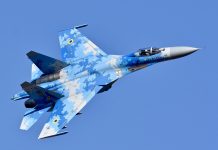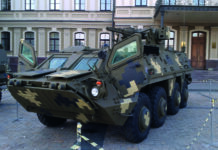For the past six months, tensions have been mounting across the globe and European security is facing new realities.
Threats to both Taiwan from China and to Ukraine from Russia have been increasing simultaneously in recent months. As we can see, one threat has already manifested in the form of a large-scale Russian invasion of Ukraine in a gross violation of the European security order, while the remaining threat around Taiwan may be realised in the near future. It is believed that in many ways, the Western reaction to Russian aggression can directly impact Beijing’s resolve to launch a military operation in Taiwan.
The War in Ukraine
On 24 February, Russia unleashed a new level of aggression against Ukraine, radically different from the hybrid attack that unfolded back in 2014. At that time, the occupation, and later annexation, of Crimea was carefully covered up as if it was the local population who sought accession (although the sham referendum in Crimea was held practically at gun-point with the massive presence of Russian military wearing no insignia), while the so-called “people’s republics” in parts of Luhansk and Donetsk regions of Ukraine were created under direct supervision of Russian intelligence and with the covert support of Russia’s regular forces confronting Ukrainian troops. But this February, Russia’s act of aggression against Ukraine was undisguised and large-scale, although the Kremlin tried to offer some pseudo-historical justifications, claiming non-subjectivity of Ukraine and presenting their goals of “demilitarisation” and “de-Nazification” of the country – something rather incomprehensible even to many Russians.
However, there is one important aspect to be noted here. Accusing Ukraine of allegedly preparing an attack on the so-called “LPR/DPR” [“people republics”], the Russians at the same time put forward demands for the inadmissibility of NATO’s eastward expansion and demanded that a package of new security guarantees be developed in Europe. Therefore, it is not surprising that today, Russia is already threatening NATO countries – over their support for Ukraine, and over Finland and Sweden’s plans to join NATO – something that wasn’t even on the table before Russia invaded Ukraine. But the main problem for Europe is that if Russia wins in Ukraine, Moscow’s next target will be nations on NATO’s eastern flank. First of all, it’s Finland, the Baltic States, and Poland.
Therefore, the war in Ukraine led to the most important shifts in the first half of the 21st century in terms of security issues for both Europe and the world. Many raise a question about NATO’s real capabilities to stand up to Russian aggression, if required. This refers to the speed of decision-making by all Allies and the promptness of deploying multinational contingents for the sake of collective defence. Also, a hot topic in recent years was how prepared the Allies are to spend the mandatory 2 per cent of GDP on defence annually. Since the United States had recently paid considerable attention to China as a persistent and key threat, considerable American military resources have been directed to the Pacific region. One might have the impression that the United States has shifted the focus away from the European continent.
A Blitzkrieg Capture of Kyiv
Nowadays, many observers are reflecting on the latest developments. In fact, Ukraine is fighting against the Russian Army, which, in various ratings, occupied leading positions in terms of overall power (based on a set of criteria). Since 2008, the Russian Army has been improving, apparently readying for the 24 February invasion, having invested billions in reform efforts thanks to favourable global prices for hydrocarbons – Russia’s main exports. The Kremlin was in a position to secure both sufficient social welfare payments and a host of defence projects. Largely based on these facts, miscalculated assessments were circulating, suggesting that Kyiv would fall in a matter of days.
Now, according to British intelligence, the number of Russian soldiers killed over the past two months amounts to 15,000, which is more than the USSR lost in the ten years of its war in Afghanistan. The estimate of Russia’s death toll, offered by the Ukrainian Army’s General Staff is even higher – more than 25,000. This means the number of wounded is approximately twice this figure.
Russia’s plan for a Blitzkrieg capture of Kyiv to topple the Ukrainian Government failed due to a combination of reasons. In many ways, Ukraine’s success (especially in the long run) is largely driven by the unprecedented support provided by the West, where the allies are now as united as ever.
However, a question arises here. Again, according to British intelligence, after the war in Ukraine ends, the Russian Army will need years to recover to pre-war levels. But will the Kremlin’s anti-NATO and anti-European rhetoric, along with the nuclear threats, disappear? And even when the war in Ukraine ends and the current regime in Russia remains in place, Europe will not be immune from seeing Putin first patch up his wounds and then start another “small victorious war” somewhere in Europe. We are already observing verbal attacks on the Baltic States and Poland, as well as threats to Finland and Sweden over their NATO plans. Moreover, there’s turbulence in the Balkans due to Russia’s influence in the region. Meanwhile, Russian national television has aired an animated clip presenting how the POSEIDON underwater drones Russia is developing could practically wipe out the British Isles, turning them into a “nuclear desert.” And it is precisely maintaining the idea of a “NATO threat” that helps the Kremlin rally the population around the need to “tighten their belts.” Therefore, the Russia-related security problem for Europe does not seem to be resolved anytime soon.
Prospect of a European Army
Under such conditions, the prospect of creating a European Army may seem quite relevant. This is not a new idea, actually. As early as the 1950s, France, Germany, Italy, and the Benelux nations sought to create a European Defence Community, but the arrangement was never ratified by the French Parliament. Then a similar idea repeatedly emerged on the agenda, especially after the end of the Cold War. On 29 April 2003, after the outbreak of the war in Iraq, which began with the invasion by the international coalition forces led by the United States and Great Britain, the leaders of Germany, France, Belgium, and Luxembourg drew up a seven-point plan to create a single European Army and reduce dependence on the US and NATO. In June 2008, French President Nicolas Sarkozy proposed that a single European Navy fleet be set up based on the aircraft carrier group operated by France and Great Britain. However, none of these plans ever came to fruition.
The idea of a European Army has become even more relevant after Russia occupied Crimea and incited a war in eastern Ukraine’s Donbas region. The EU reassessed Russia’s foreign policy, seeing it as highly aggressive. Amid mounting tensions with Russia, the then-European Commission President Jean-Claude Juncker called for a pan-European Army to send Russia a signal that the EU was serious about protecting its values. German politicians were also open to the proposals put forward by the EU head. At that time, German Chancellor Angela Merkel and Defence Minister Ursula von der Leyen said that Europe needed in-depth defence cooperation. However, it was more about projects for the future than about the need to create a European Army immediately.
A Massive Transition
The peculiarity of the idea of a European Army is that there are 28 armies in the European Union, totalling approximately 1.5 million service personnel. Defence is organised primarily at the national level, which both poses new challenges and also creates new opportunities.
The challenges are about organising such a massive transition, highlighting the strengths of each of the 28 armies and optimising them for effective operations within a single structure. The opportunities lie in the fact that the organisation of defence mainly at the national level leads to duplication of bodies and functions, as well as high costs, respectively. Therefore, one of the arguments for creating a European Army may be that the cooperation of all EU Member States will help them save on R&D and acquisition of modern weaponry and redistribute tasks so that each nation has its own military specialisation. The only question is whether all EU members will agree to transfer to Brussels the authority to deploy their troops. However, such an association could create an impetus for modernisation of defence industries, while the combined potential will significantly enhance the EU’s defensive capabilities.
European Defence and PESCO
It should be mentioned that in 2017, the Permanent Structured Cooperation (PESCO) programme was launched, a mechanism that allows EU members to cooperate closely in defence policies, while not being an alternative to NATO. Since this is about defence, which is the responsibility of each member state, participation is voluntary. The programme includes various projects that relate either to the development of various weapons and equipment or to increasing combat readiness of defence forces. There are 20 commitments made by all programme participants, including to regularly increase defence budgets and spending on new arms. There is a nuance that the countries have some similar obligations to NATO. But there are also areas that are important for the Alliance, including simplifying the procedure for transporting troops across the EU. Meanwhile, one of the problems for NATO’s eastern flank is precisely the issue of rapid deployment of troops in the event of conflict.
There is another important aspect in creating a European Army. The lack of its own armed forces prevents the EU from acting as a single player. Russia, on the contrary, is interested in establishing contacts not with the entire European society, but with each nation individually, which, as a result, increases Moscow’s influence in Europe.
As can be seen, when it comes to both European defence projects and creation of a European Army, the allegations of “competing with NATO” are immediately brought up. Such fears arise due to the fact that the total potential of the all-European Army will be inferior to that of NATO. But this would only pose a problem if NATO were to withdraw from Europe, which won’t happen. Within the framework of European integration, a whole network of parallel unions appeared, which are difficult to navigate, but in the end, new arrangements only improved cooperation rather than replaced old forms with new ones. Therefore, it is necessary to develop a form of interaction where European defence cooperation or a European Army complements NATO, and does not superimpose its functions over those of the Alliance.
By the way, another recent trend should be recalled. This is about more flexible small defensive alliances. For example, in September 2021, the US, Australia, and the UK announced an AUKUS alliance to strengthen security and stability in the Indo-Pacific region, cooperate in the field of cybersecurity, and develop artificial intelligence. It is clear that all this is happening against the backdrop of China’s rise in the region. And in January 2022, a tripartite alliance between the UK, Poland, and Ukraine was announced. The main purpose of such an alliance was to counter the Russian threat. By design, this should become part of Ukraine’s broader strategy to create smaller alliances with Lithuania, Poland, Georgia, Moldova, and Turkey. Such alliances are precisely designed to supplement the missing elements in the European security system that NATO cannot fully ensure.
A Strategic Compass for Security and Defence
After Russia invaded Ukraine, Europe started taking concrete actions to strengthen both NATO defences and those at the EU level. On 25 March, EU leaders revised and approved a more powerful military strategy, the so-called Strategic Compass. This is a notable shift in military ambitions, as previously it was characteristic of either individual nations or NATO capabilities. Work on the project was launched two years ago, but developments accelerated dramatically after Russia’s attack on Ukraine this February. So now the EU will begin work on the implementation of the project, which is also new for the Union. Here, Josep Borrell (EU High Representative for Foreign Affairs and Security Policy) stressed in advance that defence projects within the EU are not an alternative to NATO and are not set to duplicate it. On the contrary, this, in the vision of EU leaders, should make the bloc a “stronger partner” both with NATO and with “partners around the world.”
As part of the strategy, this is not about creating a European Army. Among the features of the Strategic Compass is creating a rapid response force of up to 5,000 soldiers, which is certainly a positive trend, but the Russians had gathered 120,000 troops on Ukraine’s borders prior to invading. Despite questions about the professionalism of the Russian Army, the Kremlin is still able to commit massive human resources. What will the response be if, say, the conflict flares up at once at several points on the borders of the EU?
Conclusions
However, at the moment, the Kremlin has already done enough to keep the EU moving towards further development of defence initiatives. Events that were previously considered unrealistic are already happening. Germany has announced that it will dramatically increase its defence spending and send arms to Ukraine. The European Union, which previously relied on diplomatic methods, has already sent military, humanitarian, and financial assistance to Ukraine totalling €12.8Bn. The same unexpected turn may occur with the creation of a European Army.











